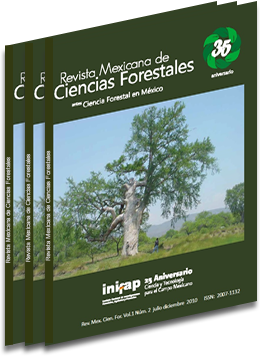DIVERSIDAD ARBÓREA Y ESTRUCTURA ESPACIAL DE BOSQUES DE PINO-ENCINO EN IXTLÁN DE JUÁREZ, OAXACA
DOI:
https://doi.org/10.29298/rmcf.v1i2.636Palabras clave:
Comunidades fitosociológicas, índices estructurales, índice Shannon, Pinus, Quercus, valor de importanciaResumen
Se realizó un análisis comparativo de la diversidad de especies arbóreas y se cuantificaron diversas variables para caracterizar la estructura espacial de rodales de pino-encino en Ixtlán de Juárez. Para ello se aplicó un muestreo aleatorio estratificado y se registró información dasométrica en 91 sitios circulares de 500 m2 cada uno. A nivel de taxón se determinó el valor de importancia y de acuerdo con el dominante se definieron ocho comunidades fitosociológicas: Pipat, Pioax, Pipse, Pidou, Piaya, Piteo, Pirud y Pilei. La diversidad arbórea se estimó mediante el Índice Shannon (H’). Con información de las parcelas de muestreo se conformaron 2,612 grupos, cada uno constituido por cinco árboles vecinos, a partir de ellos se hizo la caracterización estructural. Se determinaron: la mezcla de especies (índice Mezcla de Especies, Mi), el patrón de distribución horizontal (índice de Uniformidad, Wi) y la diferenciación de tamaños de árboles (índice de Dominancia, Ui). De acuerdo con H’, las comunidades Pipat y Piaya presentaron la mayor diversidad de árboles (2.19 y 2.10, con 26 y 19 especies, respectivamente). Las comunidades Piaya, Pilei, Pioax y Pipat, tuvieron la mezcla de especies más alta (0.591< Mi < 0.687); en las ocho comunidades fitosociológicas el arreglo espacial fue aleatorio (0.530 < Wi < 0.569). El análisis del tamaño de los diámetros, por comunidad mostró que de 46-51% de los árboles fueron más delgados que los individuos de referencia. Se concluye que la diversidad de especies arbóreas y la estructura de los rodales son diferentes en función de la comunidad fitosociológica.
Descargas
Descargas
Publicado
Cómo citar
Número
Sección
Licencia
Los autores que publiquen en la Revista Mexicana de Ciencias Forestales aceptan las siguientes condiciones:
De acuerdo con la legislación de derechos de autor, la Revista Mexicana de Ciencias Forestales reconoce y respeta el derecho moral de los autores, así como la titularidad del derecho patrimonial, el cual será cedido a la revista para su difusión en acceso abierto.
Todos los textos publicados por la Revista Mexicana de Ciencias Forestales –sin excepción– se distribuyen amparados bajo la licenciaCreative Commons 4.0 Atribución-No Comercial (CC BY-NC 4.0 Internacional), que permite a terceros utilizar lo publicado siempre que mencionen la autoría del trabajo y a la primera publicación en esta revista. (no permite el uso comercial)
Los autores pueden realizar otros acuerdos contractuales independientes y adicionales para la distribución no exclusiva de la versión del artículo publicado en la Revista Mexicana de Ciencias Forestales (por ejemplo, incluirlo en un repositorio institucional o darlo a conocer en otros medios en papel o electrónicos) siempre que indique clara y explícitamente que el trabajo se publicó por primera vez en la Revista Mexicana de Ciencias Forestales.
Para todo lo anterior, los autores deben remitir el formato de carta-cesión de la propiedad de los derechos de la primera publicación debidamente requisitado y firmado por los autores/as. Este formato debe ser remitido en archivo PDF al correo: editorial.forestal@inifap.gob.mx
Esta obra está bajo una licencia de Creative Commons Reconocimiento-No Comercial 4.0 Internacional.






